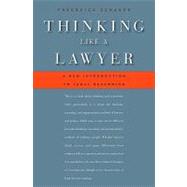
What is included with this book?
| Preface | p. xi |
| Introduction: Is There Legal Reasoning? | p. 1 |
| Rules-in Laws and Elsewhere | p. 13 |
| Of Rules in General | p. 13 |
| The Core and the Fringe | p. 18 |
| The Generality of Rules | p. 24 |
| The Formality of Law | p. 29 |
| The Practice and Problems of Precedent | p. 36 |
| Precedent in Two Directions | p. 36 |
| Precedent-The Basic Concept | p. 37 |
| A Strange Idea | p. 41 |
| On Identifying a Precedent | p. 44 |
| Of Holdings and Dicta | p. 54 |
| On the Force of Precedent-Overruling, Distinguishing, and Other Types of Avoidance | p. 57 |
| Authority and Authorities | p. 61 |
| The Idea of Authority | p. 61 |
| On Binding and So-Called Persuasive Authority | p. 67 |
| Why Real Authority Need Not Be "Binding" | p. 75 |
| Can There Be Prohibited Authorities? | p. 77 |
| How Do Authorities Become Authoritative? | p. 80 |
| The Use and Abuse of Analogies | p. 85 |
| On Distinguishing Precedent from Analogy | p. 85 |
| On the Determination of Similarity | p. 92 |
| The Skeptical Challenge | p. 96 |
| Analogy and the Speed of Legal Change | p. 100 |
| The Idea of the Common Law | p. 103 |
| Some History and a Comparison | p. 103 |
| On the Nature of the Common Law | p. 108 |
| How Does the Common Law Change? | p. 112 |
| Is the Common Law Law? | p. 117 |
| A Short Tour of the Realm of Equity | p. 119 |
| The Challenge of Legal Realism | p. 124 |
| Do Rules and Precedents Decide Cases? | p. 124 |
| Does Doctrine Constrain Even If It Does Not Direct? | p. 134 |
| An Empirical Claims | p. 138 |
| Realism and the Role of the Lawyer | p. 142 |
| Critical Legal Studies and Realism in Modern Dress | p. 144 |
| The Interpretation of Statutes | p. 148 |
| Statutory Interpretation in the Regulatory State | p. 148 |
| The Role of the Text | p. 151 |
| When the Text Provides No Answer | p. 158 |
| When the Text Provides a Bad Answer | p. 163 |
| The Canons of Statutory Construction | p. 167 |
| The Judicial Opinion | p. 171 |
| The Causes and Consequences of Judicial Opinions | p. 171 |
| Giving Reasons | p. 175 |
| Holding and Dicta Revisited | p. 180 |
| The Declining Frequency of Opinions | p. 184 |
| Making Law with Rules and Standards | p. 188 |
| The Basic Distriction | p. 188 |
| Rules, Standards, and the Question of Discretion | p. 190 |
| Stability and Flexibility | p. 194 |
| Rules and Standards in Judicial Opinions | p. 196 |
| On the Relation between Breadth and Vagueness | p. 200 |
| Law and Fact | p. 203 |
| On the Idea of a Fact | p. 203 |
| Determining Facts at Trial-The Law of Evidence and Its Critics | p. 206 |
| Facts and the Appellate Process | p. 212 |
| The Burden of Proof and Its Cousins | p. 219 |
| The Burden of Proof | p. 219 |
| Presumptions | p. 224 |
| Deference and the Allocation of Decision-Making Responsibility | p. 229 |
| Index | p. 235 |
| Table of Contents provided by Ingram. All Rights Reserved. |
The New copy of this book will include any supplemental materials advertised. Please check the title of the book to determine if it should include any access cards, study guides, lab manuals, CDs, etc.
The Used, Rental and eBook copies of this book are not guaranteed to include any supplemental materials. Typically, only the book itself is included. This is true even if the title states it includes any access cards, study guides, lab manuals, CDs, etc.